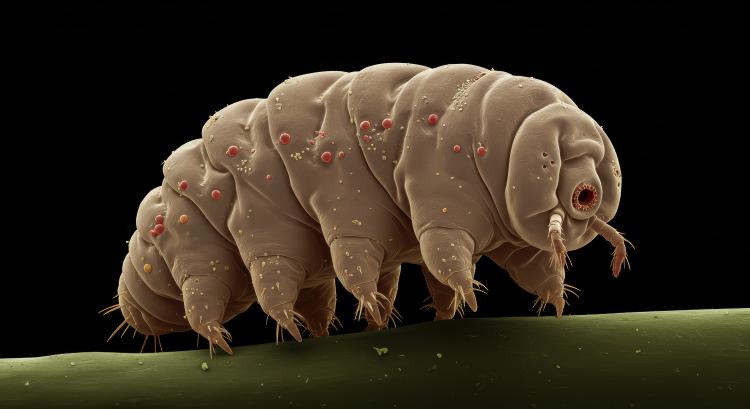A better band-aid: New 'suspended animation' technology could revolutionize wound care
Professor Christopher Bowman, left, and members of his research team demonstrate how light is used to activate a novel treatment for frostbite, severe burns, battlefield wounds and more. Credit: Glenn Asakawa/CU Boulder
Burn your hand on a hot stove and, almost instantly, immune cells within the wound begin producing inflammatory compounds to help clear out dead tissue and fight off infection. In most cases, the swelling abates quickly, and the wound heals within days.
But for the 600,000 or so people in the United States who suffer serious burns each year, the immune response itself can cause problems, with prolonged inflammation tearing through surrounding tissue and increasing risk of scarring, disfigurement and disability.
A team of CU Boulder scientists hopes to minimize such long-term damage by suspending that cellular immune response until the body, or care providers, are better equipped to deal with it.
Funded by a new up-to-$5.8 million, two-year contract from the Advanced Research Projects Agency for Health (ARPA-H), the project could lead to new treatments for a host of serious tissue injuries, from battlefield blast wounds to frostbite and diabetic ulcers. It could be particularly useful for those without immediate access to care.
“The ultimate goal is to help patients have less pain, faster healing and less systemic damage,” said Christopher Bowman, professor of chemical and biological engineering and co-principal investigator on the project. “It could also save lives.”

An AI rendering of a tardigrade, or 'water bear.' The microscopic animal goes into 'biostasis' to survive extreme temperatures, and served as inspiration for a new wound care technology. Credit: Adobe stock

Christopher Bowman, research assistant Maria Lemon, seated, senior research associate Ben Fairbanks, in background, and postdoctoral researcher Jessica Stelzel. (Photo by Glenn J. Asakawa/University of Colorado)
Suspended animation for cells
The new “Tissue Preservation Under Stress” (TPS) project grew out of a years-long CU Boulder effort, funded by the U.S. Defense Advanced Research Projects Agency (DARPA), to develop novel ways to keep battlefield injuries from worsening as soldiers awaited transport.
Since 2018, the CU team has centered their research around a seemingly sci-fi process called “biostasis,” in which certain organisms temporarily shut down cellular processes to survive harsh conditions. For instance, in extremely cold temperatures, a microanimal called a tardigrade, a.k.a. water bear, slows its cellular function to a stand-still. When temperatures warm, the cells awaken from hibernation.
“The big picture idea was that you could possibly put injured tissue in biostasis until transport to a medical facility could occur,” explained Kristi Anseth, professor of chemical and biological engineering and co-principal investigator on the TPS project.
To induce biostasis in mammalian cells, Bowman, and a multidisciplinary team from CU’s BioFrontiers Institute, developed a specialized hydrogel—essentially a biodegradable 3D plastic— which, upon entering cells, spreads out like a net to stop proteins, enzymes and other molecules inside from moving around.
“It’s like freezing without the ice,” said Senior Research Associate Benjamin Fairbanks, who has been working on the technology for years. “It is a completely different way of addressing the problem,” of serious wounds.
Once light is shined on the cells, the hydrogel degrades and normal cellular activity resumes, according to a paper published in the journal Advanced Materials in 2022.
Subsequent studies on simulated skin in the lab show that when the hydrogel material is applied, healing stalls, and once the polymer degrades, healing resumes.
Pilot studies in animals have also shown promise.
“You basically protect the tissue from its own responses until the initial trauma passes and then bring the cells back to full activity,” said Bowman.
A smarter band-aid
ARPA-H was founded in 2022 with a mission to fast-track “high-impact solutions to society’s most challenging health problems.”
In its announcement about the new TPS contract, the agency named traumatic tissue injuries among those major challenges.
“Despite advancement in wound care, millions of Americans lack immediate access to specialized medical facilities, increasing the risk of chronic wounds or death.”
Studies show burns account for as many as 20% of battlefield injuries too, with most caused by blasts from explosive devices. In those cases, prolonged inflammation can make it hard to preserve limbs. Biostasis could potentially make it easier, suspects Bowman.
More research is necessary before the technology is ready for use in people, but the potential applications are broad.
Anseth and Bowman envision a day when hydrogel-infused bandages could be used by soldiers in the field, carried on mountaineering expeditions (where frostbite is common), or used in remote health clinics, where resources for treating serious burns or wounds are limited and patients must often be transported.
It may also have applications in cancer treatment someday, to minimize the impact of burns from radiation therapy.
The new infusion of federal dollars could make these possibilities come sooner.
“What’s really special about this funding is that it bridges the gap between fundamental science and clinical application and it makes you think big,” said Anseth. “It’s exciting to be a part of that.”


